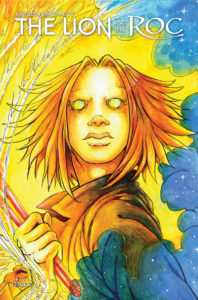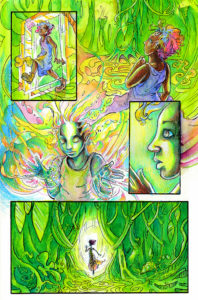Kathleen Kralowec dishs on The Lion and the Roc

Kathleen Kralowec is a name that you may not currently recognize, but she is certainly one that you should remember. Here at CCN we’ve met quite a number of creators over the years, Kathleen is a creator whose work stood out and were very happy to bring you an inside look into her creator-owned series…
The Lion and the Roc!
Mark Mazz: The Lion and the Roc is quite engrossing from the first page. It’s a grand quest which includes the rearing of two central characters by two less than reputable former devotees of the Goddess Magorra. It starts with the transformation of the two less-than-devout characters into mystical beings. What’s the overall arc going to entail? What locales will we visit?
![]()
 Kathleen Kralowec: The overall arc is about how Parable ultimately responds to the many different factions who want to control or influence her power, and what she decides to do with that power once she’s old enough to understand it. You’ll have noticed by issue 3 the looming suggestion of a city, quite possibly a city in peril or in a state of destruction. Gustovelt, who considers herself a non-human, refers to the rainforest as “Green-Time,” because time in the rainforest is dictated by the thoughts of plants. Gustovelt refers to all cities and human-controlled spaces as “Human Law,” because, in those places, human-centric rules dictate everything: who lives and dies, what eats what, what can and can’t exist and what thoughts are possible. Gustovelt scoffs at Human Law, calls it not a place for beings like herself and Parable, and resents anyone who brings up the possibility that Parable’s destiny lies there.
Kathleen Kralowec: The overall arc is about how Parable ultimately responds to the many different factions who want to control or influence her power, and what she decides to do with that power once she’s old enough to understand it. You’ll have noticed by issue 3 the looming suggestion of a city, quite possibly a city in peril or in a state of destruction. Gustovelt, who considers herself a non-human, refers to the rainforest as “Green-Time,” because time in the rainforest is dictated by the thoughts of plants. Gustovelt refers to all cities and human-controlled spaces as “Human Law,” because, in those places, human-centric rules dictate everything: who lives and dies, what eats what, what can and can’t exist and what thoughts are possible. Gustovelt scoffs at Human Law, calls it not a place for beings like herself and Parable, and resents anyone who brings up the possibility that Parable’s destiny lies there.
 MM: I have to say that I’ve found your characterization of your players to be quite engaging and solid. How much of this story do you have worked out? Is there multiple story arcs planned, multiple collected novels?
MM: I have to say that I’ve found your characterization of your players to be quite engaging and solid. How much of this story do you have worked out? Is there multiple story arcs planned, multiple collected novels?
KK: I’ve worked out at least several trades—there are definitely multiple story arcs planned which will become at least 5 trades once its all said and done.
MM: In the series, Bright Brigid tells us she has no experience with kids. How much of this is your inner muse, and how much is this your own experience?
KK: I definitely grew up not wanting anything to do with kids, nor interested in parenthood. Brigid is definitely coming from a similar place.
MM: There’s a whole pantheon of characters, goddesses, and mystical beings in The Lion and the Roc, which you’ve built from scratch. Are you drawing on any particular sources? Will they become part of the series?
KK: I am consciously trying to deviate from traditional mythological beings in this work, partly for the sake of artistic license, and partly to shake the audience from their expectations of certain familiar monsters. Also, to keep real-world religions and their gods out of this fictional exploration. Ancient deities are occasionally made the characters of comics without seemingly offending anyone, but I wanted more distance, so the gods and goddesses are analogues to those from real myths, but not direct references. I have a great deal of respect and interest in Nordic mythology, and while those gods are influencing certain characters in this story, I didn’t want to directly bring them in. I think real-world people have real-world relationships with many different pantheons, and by forging imagined gods, I hope readers can come to them fresh. This world is definitely parallel to our own, it’s had many civilizations in its history which are similar to those in our own’s, but not identical. The religions that’ve been in control in the Lion and the Roc world are not the same ones that’ve been part of this one.
MM: Prince Cassander’s background shows him as a Romanesque conqueror, and High priestess Bellasunna presumably is of a sea-faring Mediterranean culture… are their cultural backgrounds an integral part of the story?
Their story is also a story of invasion by foreign power, being swayed by the exotic and strange, and also cultural obsessions with glory.
 MM: I love the set-up of Prince Cassander being entrapped in a glowing, floating, mystical crystal ball. This has so many classical mythic overtones. Is there one in particular you are drawing on?
MM: I love the set-up of Prince Cassander being entrapped in a glowing, floating, mystical crystal ball. This has so many classical mythic overtones. Is there one in particular you are drawing on?
KK: In some ways Cassander’s lot is similar to the entity who lives in the evil queen’s mirror in Snow White. We never learn much about that entity, in any of the renditions of the story I’ve heard, he never seems to have much of an agenda of his own. Cassander’s lot is particularly unfortunate since he is a person who at least once had a will and desires, who has been forced into the role of a conduit between asker and information; a role ill-suited to someone with ideas of their own, but then, it is meant to be a punishment.
Cassander is condemned to dwell in a library of all knowledge, unable to experience the world himself directly, his own memories manifesting as objects around him. We’ll get a lot more into his lot in issue 4. The theme of a gigantic library surfaces in a lot of stories, even in Game of Thrones we’ve had the introduction of a vast library. The Library of Babel is a book by Borges in which the library becomes a labyrinth and also prison, housing all the world’s knowledge but preventing readers from applying anything they learn. An interesting web project about the Library of Babel (www.libraryofbabel.info) also exists, which suggests the idea of all the possible knowledge in the universe being housed in a single place. I’d also point out that, as Cassander is imprisoned in a crystal ball, he is also in the role of a personality and set of memories which have been recorded as digital information into a computer’s memory (silicon being a form of crystal) and is imprisoned amongst the data which various sources have recorded in a single database. So there’s a sci-fi element there as well.
 MM: From the moment that I first looked at the work, it’s crisp clear storytelling was quite apparent. What are your storytelling influences? Where do you draw your inspiration from?
MM: From the moment that I first looked at the work, it’s crisp clear storytelling was quite apparent. What are your storytelling influences? Where do you draw your inspiration from?
KK: I feel like I have been a storyteller as long as I’ve been an artist, maybe even longer. I’ve been working on this story for a really long time, and it’s really exciting to finally be sharing it and getting feedback. I took a writing workshop back in Santa Cruz to work out a few things in the story, and it was useful to just get feedback from others working on books (I was the only one working on a comic book script) and then later I read The Golden Theme by Brian McDonald, which I think was really important and influential to me recently. His other book Invisible Ink was also pretty huge.
MM: You touch on the belief systems of a few cultures, and how they create new opportunities for your characters. Are you shining a mirror on how beliefs actually create the living reality for so many of us?
KK: I hope to get across that every single person who sees Parable’s power interprets that power completely differently, and this is largely determined by where they come from and what they believe. The characters work in such things as seeming miracles and magic into corresponding, existing spaces in their own idea of how the world works. Where some people see a danger and infernal threat, others will see hope and evidence for something they’ve always hoped for.
 MM: What brought you to the world of comics? What’s your very first memories of reading comics? And what works have keep you around during your development as a writer & artist?
MM: What brought you to the world of comics? What’s your very first memories of reading comics? And what works have keep you around during your development as a writer & artist?
KK: The very first comic that grabbed my attention was The Maxx. I was going through a garage sale in Fresno’s Tower District and in this box was a comic unlike any other I’d ever seen, and it was an issue of The Maxx. There were a few random issues from The Maxx in the box and I bought them all. I had no idea that you were supposed to read comics starting from issue 1, and I was really confused about the story, but the art was different than any I’d ever seen and it was huge for me to see comic books in a style that was different from the super-hero style. Later on I discovered The Sandman, which I also read totally out of order, but was further proof that you can do amazing things in the comics genre.
 MM: Comicker Digital is a relatively new player in the field. How did you get started with them? Can you share a link with us so we can find where to purchase the books?
MM: Comicker Digital is a relatively new player in the field. How did you get started with them? Can you share a link with us so we can find where to purchase the books?
KK: I had my eye on Comicker for a while before reaching out. The titles they had on their website seemed pretty awesome, and it looked to me like a good place to reach out to for publishing. There are more and more small publishers these days, and in a few years I predict indie comic book creators are going to have a lot of options. I’m glad I’m on board with Comicker Digital at this stage: this year they’re opening up the print branch of their operations for the first time, so its exciting.
You can get issue 1 of The Lion and the Roc digitally at any of the sites below, and if you want a print copy you can find info at www.KathleenKralowec.com
Amazon: http://tinyurl.com/LRonKindle
Comixology: http://tinyurl.com/
DriveThruComics: http://tinyurl.com/

Leave a Reply